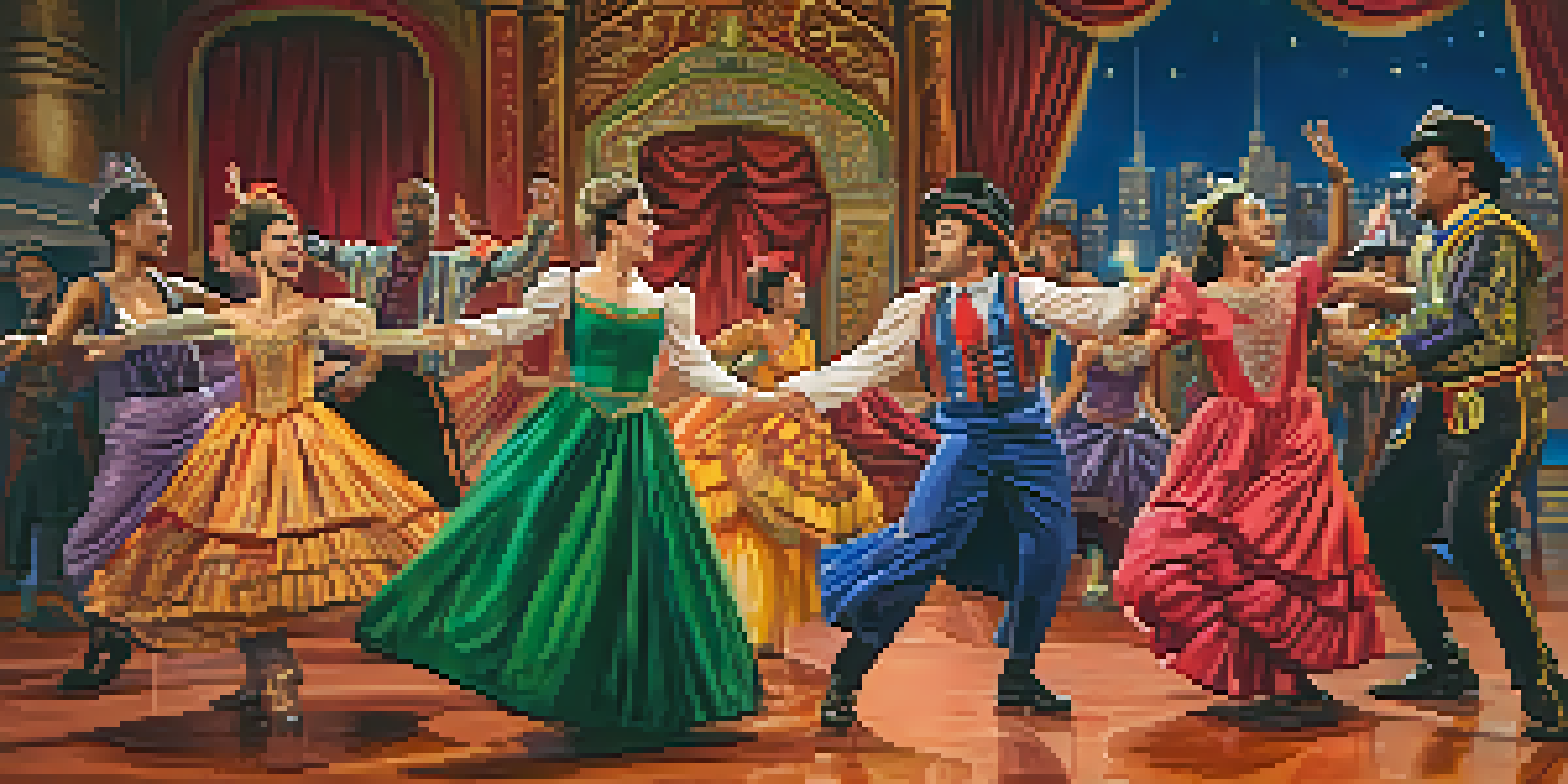The Story of NYC's Community Theaters: A Cultural Exploration

The Roots of Community Theater in New York City
Community theater in New York City dates back to the early 20th century, when local groups began producing plays to entertain and unite neighborhoods. These grassroots organizations emerged as a response to the growing urban population and the desire for artistic expression beyond the commercial Broadway scene. They provided a platform for aspiring actors, playwrights, and directors to showcase their talents.
The theater is a world of the imagination, and we are the storytellers who bring dreams to life.
As NYC's diverse population grew, so did the themes and styles of community theater. These productions often reflected the cultural backgrounds of the neighborhoods they served, incorporating languages, traditions, and stories unique to each community. This inclusiveness not only enriched the local arts scene but also fostered a sense of belonging among residents.
Today, many of these community theaters continue to thrive, adapting to modern challenges while staying true to their roots. They offer a space for collaboration, creativity, and cultural exchange, reminding us that the heart of theater lies in its ability to connect people from all walks of life.
Key Players in NYC's Community Theater Scene
Throughout its history, NYC's community theater scene has been shaped by influential individuals and organizations. Notable figures such as Ellen Stewart, founder of La MaMa Experimental Theatre Club, championed avant-garde productions and provided a nurturing environment for emerging artists. Her vision and dedication helped elevate the status of community theater in the city.

In addition to individual visionaries, numerous community-based organizations have played a crucial role in sustaining and promoting local theater. Groups like the New York Theater Workshop and The Public Theater have created opportunities for collaboration and outreach, bridging the gap between professional and amateur artists. Their efforts have not only expanded the reach of community theater but also enriched the cultural fabric of NYC.
Community Theater's Cultural Impact
Community theaters in NYC serve as vital spaces for exploring and expressing diverse cultural identities, fostering pride and connection within local communities.
The support of these key players has been vital in fostering a vibrant community theater ecosystem. By providing resources, mentorship, and performance spaces, they empower artists to take risks and explore innovative storytelling, ensuring that community theater remains a dynamic and essential part of NYC's landscape.
The Role of Community Theater in Cultural Identity
Community theaters in NYC serve as important venues for exploring and expressing cultural identities. They provide a platform for underrepresented voices, allowing artists to share their unique experiences and perspectives. Through plays and performances, these theaters challenge stereotypes and promote understanding among diverse audiences.
Art is the most beautiful of all lies; it is the most realistic expression of the truth.
For many immigrant communities, local theaters are a bridge to their heritage, offering productions in native languages and themes that resonate with their cultural narratives. This cultural exploration fosters pride and connection, not only for the performers but also for the audience members who see their stories represented on stage. It creates a shared experience that strengthens community bonds.
In this way, community theater becomes a powerful tool for dialogue and transformation. By celebrating cultural diversity and encouraging discussions around identity, these theaters help shape a more inclusive society, reminding us that every story has value and deserves to be told.
Challenges Facing NYC's Community Theaters
Despite their rich history, community theaters in NYC face several challenges that threaten their sustainability. Funding limitations, rising rent costs, and competition from larger theater companies often make it difficult for these organizations to thrive. Many rely on grants, donations, and ticket sales, which can fluctuate significantly, leaving them vulnerable.
Moreover, the impact of the COVID-19 pandemic has further complicated the landscape for community theaters. Many were forced to close temporarily or shift to virtual performances, which presented its own set of challenges. As audiences return, theaters must find innovative ways to engage their communities and rebuild their audiences.
Challenges for Community Theaters
NYC's community theaters face significant challenges like funding limitations and rising costs, which threaten their sustainability and ability to engage audiences.
Addressing these challenges requires resilience and creativity from community theater leaders. By forging partnerships, diversifying funding sources, and embracing new technologies, these organizations can navigate the changing environment and continue to serve as vital cultural hubs in New York City.
The Impact of Community Theater on Local Communities
Community theater has a profound impact on local neighborhoods, often serving as a catalyst for social change and community engagement. By addressing pressing social issues through their productions, these theaters raise awareness and encourage dialogue among residents. Topics such as immigration, identity, and social justice frequently take center stage, prompting audiences to reflect on their own experiences.
Additionally, community theaters foster a sense of belonging and pride among residents. They provide a space for collaboration, where people from different backgrounds come together to create art. This shared experience cultivates relationships and strengthens community ties, making theater a vital part of local identity.
As community theaters continue to engage with their neighborhoods, their influence extends beyond the stage. They inspire local initiatives, support education programs, and encourage civic participation, ultimately shaping a more vibrant and connected community.
Innovations in Community Theater: Embracing Change
As the landscape of theater evolves, many community theaters in NYC are embracing innovation to stay relevant. This includes incorporating technology into their productions, such as live streaming performances or using social media to engage with audiences. By adapting to modern trends, these theaters can reach wider audiences and attract younger generations.
Another area of innovation is the exploration of new formats and styles of storytelling. Many community theaters are experimenting with immersive theater experiences, where audiences become part of the narrative. This fresh approach not only captivates viewers but also encourages deeper engagement with the material.
Innovations Shaping Theater's Future
Community theaters are embracing innovation through technology and new storytelling formats to attract younger audiences and remain relevant in a changing cultural landscape.
Moreover, collaborations with other art forms, such as dance, visual arts, and music, are becoming increasingly common. These interdisciplinary projects help to break down barriers and create unique experiences that resonate with diverse audiences, ensuring that community theater continues to evolve and thrive.
Looking Ahead: The Future of NYC's Community Theaters
The future of NYC's community theaters holds great promise, as they continue to adapt and grow in response to the changing cultural landscape. With a renewed focus on inclusivity and representation, these theaters are poised to amplify the voices of marginalized communities and foster a more equitable arts environment. Their commitment to diversity will only strengthen their relevance in the years to come.
Moreover, as technology continues to advance, community theaters have the opportunity to explore new avenues for creativity and audience engagement. By embracing digital platforms and innovative storytelling techniques, they can expand their reach and create more immersive experiences for viewers. This adaptability will be crucial in attracting a new generation of theatergoers.

Ultimately, the resilience and passion of community theater artists and organizations will ensure that these cultural treasures remain an integral part of NYC's artistic landscape. As they continue to inspire, connect, and challenge audiences, community theaters will undoubtedly play a vital role in shaping the city's cultural identity for years to come.